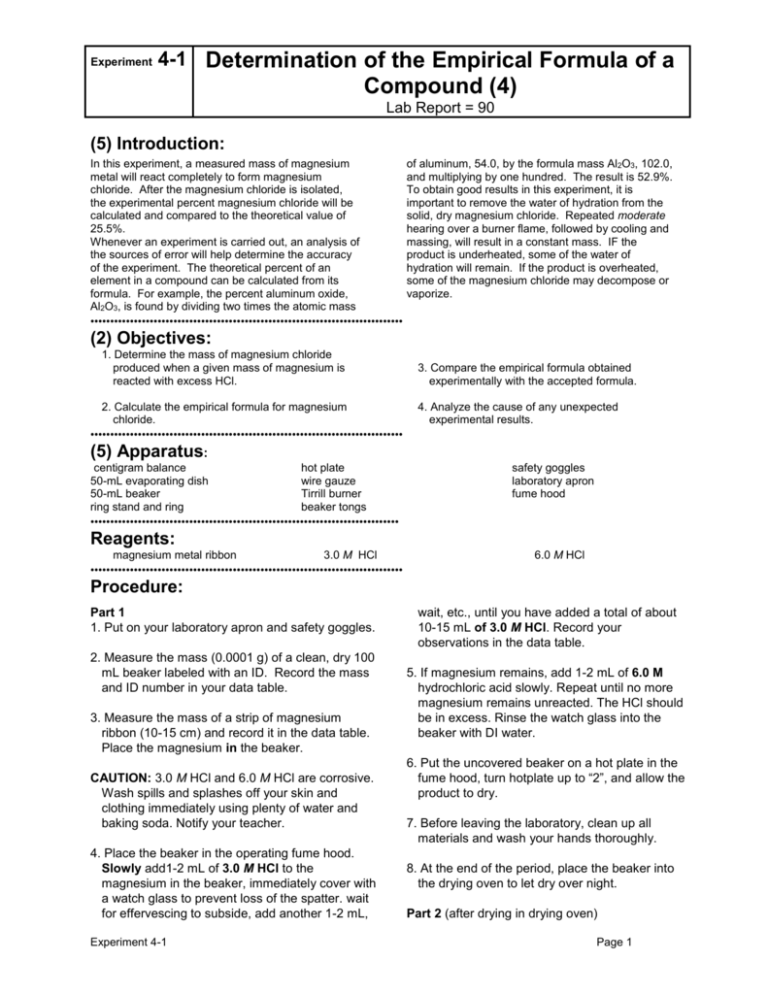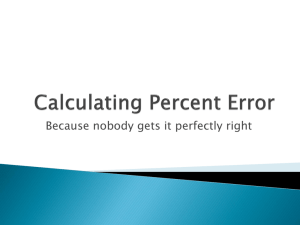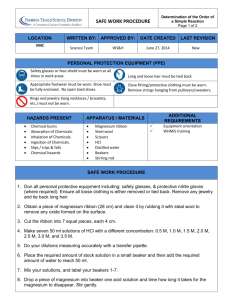Experiment 0-0
advertisement

Experiment 4-1 Determination of the Empirical Formula of a Compound (4) Lab Report = 90 (5) Introduction: In this experiment, a measured mass of magnesium metal will react completely to form magnesium chloride. After the magnesium chloride is isolated, the experimental percent magnesium chloride will be calculated and compared to the theoretical value of 25.5%. Whenever an experiment is carried out, an analysis of the sources of error will help determine the accuracy of the experiment. The theoretical percent of an element in a compound can be calculated from its formula. For example, the percent aluminum oxide, Al2O3, is found by dividing two times the atomic mass ••••••••••••••••••••••••••••••••••••••••••••••••••••••••••••••••••••••••••••••• of aluminum, 54.0, by the formula mass Al2O3, 102.0, and multiplying by one hundred. The result is 52.9%. To obtain good results in this experiment, it is important to remove the water of hydration from the solid, dry magnesium chloride. Repeated moderate hearing over a burner flame, followed by cooling and massing, will result in a constant mass. IF the product is underheated, some of the water of hydration will remain. If the product is overheated, some of the magnesium chloride may decompose or vaporize. (2) Objectives: 1. Determine the mass of magnesium chloride produced when a given mass of magnesium is reacted with excess HCl. 2. Calculate the empirical formula for magnesium chloride. ••••••••••••••••••••••••••••••••••••••••••••••••••••••••••••••••••••••••••••••• 3. Compare the empirical formula obtained experimentally with the accepted formula. 4. Analyze the cause of any unexpected experimental results. (5) Apparatus: centigram balance hot plate 50-mL evaporating dish wire gauze 50-mL beaker Tirrill burner ring stand and ring beaker tongs •••••••••••••••••••••••••••••••••••••••••••••••••••••••••••••••••••••••••••••• safety goggles laboratory apron fume hood Reagents: 3.0 M HCl magnesium metal ribbon ••••••••••••••••••••••••••••••••••••••••••••••••••••••••••••••••••••••••••••••• 6.0 M HCl Procedure: Part 1 1. Put on your laboratory apron and safety goggles. 2. Measure the mass (0.0001 g) of a clean, dry 100 mL beaker labeled with an ID. Record the mass and ID number in your data table. 3. Measure the mass of a strip of magnesium ribbon (10-15 cm) and record it in the data table. Place the magnesium in the beaker. CAUTION: 3.0 M HCl and 6.0 M HCl are corrosive. Wash spills and splashes off your skin and clothing immediately using plenty of water and baking soda. Notify your teacher. 4. Place the beaker in the operating fume hood. Slowly add1-2 mL of 3.0 M HCl to the magnesium in the beaker, immediately cover with a watch glass to prevent loss of the spatter. wait for effervescing to subside, add another 1-2 mL, Experiment 4-1 wait, etc., until you have added a total of about 10-15 mL of 3.0 M HCl. Record your observations in the data table. 5. If magnesium remains, add 1-2 mL of 6.0 M hydrochloric acid slowly. Repeat until no more magnesium remains unreacted. The HCl should be in excess. Rinse the watch glass into the beaker with DI water. 6. Put the uncovered beaker on a hot plate in the fume hood, turn hotplate up to “2”, and allow the product to dry. 7. Before leaving the laboratory, clean up all materials and wash your hands thoroughly. 8. At the end of the period, place the beaker into the drying oven to let dry over night. Part 2 (after drying in drying oven) Page 1 9. Put on your laboratory apron and safety goggles. 13. Measure the mass of the beaker and magnesium chloride. 10. Record your observations of the beaker contents in your notebook. 14. Dispose of the magnesium chloride by dissolving it and washing the solution down the drain. 11. Measure the mass of the beaker and magnesium chloride. Record the data in the data table. 15. Record your data on the class data table. 12. Set up a ring stand and wire gauze. Using a Tirrill burner heat the beaker and contents until no liquid is apparent. Allow the beaker to cool unitl room temperature about 15 mins. 16. Before leaving the laboratory, wash your hands thoroughly. ••••••••••••••••••••••••••••••••••••••••••••••••••••••••••••••••••••••••••••••• (22) Data and Observations: Identification number of beaker Mass of beaker Mass of magnesium Mass of beaker and magnesium chloride after hot plate Mass of beaker and magnesium chloride after heating Observations while adding HCl: Observations of the product after drying overnight: (10) Experiment 4.1 Class Data Period -------- Team 2 3 4 5 6 7 8 9 --------- Mass Mg (g) Mass MgCl2 (g) ----------------- Average % Mg Deviation ••••••••••••••••••••••••••••••••••••••••••••••••••••••••••••••••••••••••••••••• Experiment 4-1 Page 2 (26) Calculations: Show all derivations! (2) 1. How much magnesium reacted? (2) 7. Use the results of calculations 1 and 3 to determine the percent magnesium in magnesium chloride. (2) 2. Calculate the moles of magnesium that reacted. (2) 8. Calculate the class average percent magnesium in the product. (2) 3. Calculate the mass of magnesium chloride produced. (4) 9. Calculate the deviation of each determination of the percent magnesium from the average. (Deviation is basically how much the data is off from the average.) Show one derivation, not all. (2) 4. How many grams of chlorine reacted? (2) 5. Calculated the number of moles of chlorine that reacted. (2) 6. Use the results of Calculations 2 and 5 to determine the ratio of chlorine atoms to magnesium atoms in magnesium chloride, and write the formula for magnesium chloride. (2) 10. Calculate the average deviation. (2) 11. Calculate the percent error for your team value. (2) 12. Calculate the percent error for the class average value. ••••••••••••••••••••••••••••••••••••••••••••••••••••••••••••••••••••••••••••••• (16) Analysis: (4) 1. Explain why an experimental error is more likely to by made in the mass of the magnesium chloride than the mass of the magnesium. (4) 2. Compare your experimental percent magnesium to the theoretical percent calculated in Prelab Question 4. Suggest a cause for any experimental error. Experiment 4-1 (2) 3. Compare the class results to the theoretical results. Are the errors random or systematic? (2) 4. What is the maximum percent yield possible in a reaction? (4) 5. Suggest ways this experiment could be improved. Page 3







